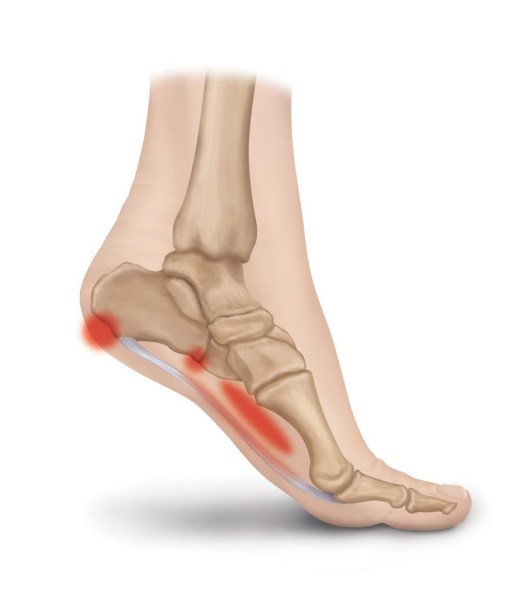Plantar Fasciopathy - Pain Under The Foot
Plantar Fasciopathy – Pain under the foot
Sometimes known as plantar fasciitis, this condition is an overuse injury that results in pain mainly under the heel of the foot, sometimes radiating down the foot to the toes. Pain is often worst with the first steps after waking in the morning, or after a long period of inactivity.

Why does plantar fasciopathy occur in the first place?
Plantar fasciopathy is an overuse injury that typically arising when you increase or change your training load of weight bearing exercises such as running or hiking up hills. When the training load is increased too quickly the plantar fascia tissue underneath the foot becomes irritated where it originates at the base near the heel of the foot. Other factors that may contribute to your pain are:
- Beginning a new form of exercise after a period of inactivity.
- Weakness in the foot, calf or hip control muscles.
- Tightness in the calf muscles and stiffness in your foot joints.
What are the treatments that physiotherapists can provide?
Physiotherapy has a few select treatment methods that research shows can help the treatment of plantar fascia both in the short and long term.
Initially manual therapy for your foot and lower leg, stretching exercises and taping techniques for your foot will be used to help manage your pain. To help decrease your initial pain, it is integral you have a discussion with your physiotherapist about load management. This means working out how much activity you can perform to not lose too much strength from inactivity, but also give your tissues enough rest in order to settle down. For a complete recovery from this condition, a strengthening program will be implemented to help improve the resilience of the tissues in your lower leg. This will also help accelerate your return to your sport and assist in preventing future overuse injuries.
Other treatments that have been shown to help plantar fascia pain are foot orthotics prescribed by a podiatrist. Doing this may help correct your foot posture and unload your tissues. Your physio will advise you on whether or not orthotics may be appropriate for you.
Is there anything I can do at home to help?
Firstly, be compliant with the exercises and advice your physiotherapist has provided. However when trying to reload your tissues, mistakes can be made and your pain can increase by accident. The two best ways to try and decrease your pain if this happens are:
- Applying ice to the injured site. This can be as simple as placing your foot gently on an ice pack. Ensure your wrap the ice pack in a damp tea-towel and apply to the area for a maximum of 10-20min, always checking for signs of ice burn.
- Trying to wear comfy shoes around the house. Walking barefoot can sometimes irritate the origin of the plantar fascia.
Plantar fasciopathy is a well-researched condition that we see significant improvements in every day. However we do know it can be a tricky pathology to manage well, so the team here at South City will be here to help you every step of the way!
Written by Ben Cunningham, Physiotherapist

